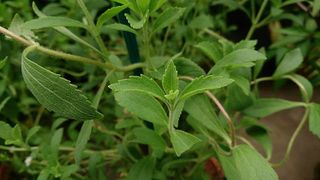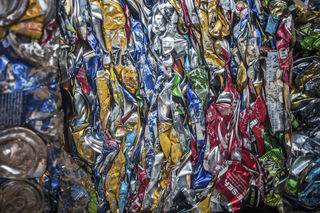Diet
Sugar by Any Other Name? Low Calorie Sweeteners
Why is there still confusion about sugar substitutes?
Posted December 27, 2016
There is a digital image currently on exhibit at the James A. Michener Art Museum in Doylestown, Pennsylvania by Seattle-based artist Chris Jordan. Jordan ingeniously uses Georges Seurat’s iconic painting A Sunday Afternoon on the Island of La Grande Jatte (1884-1886) (immortalized by Stephen Sondheim’s 1984 musical Sunday in the Park with George) as his template. Appropriating a version of pointillism, he has replaced all the thousands of Seurat’s dots of color with 106,000 miniaturized aluminum cans of soda. For Jordan, who aptly calls his 2007 piece Cans Seurat, we are undoubtedly a culture of consumerism: 106,000 apparently represent the number of cans that U.S. consumers drink every thirty seconds.

There is nothing particularly more obesogenic about liquid calories, as for example, from our drinking cans of soda. (Allison, British Journal of Nutrition, 2014) After all, all calories count. There is, though, now scientific evidence from both experimental trials and observational studies that suggest that our consumption of sugar-sweetened sodas may cause excessive weight gain because of an excessive intake of calories and our often incomplete compensation for these excessive liquid calories at subsequent meals, at least in the short term. (Allison, 2014) As a result, sugar-sweetened sodas have been associated with an increased risk of type 2 diabetes and cardiovascular disease. (Malik and Hu, Journal of the American College of Cardiology, 2015).

Sugar was initially considered a “nutritional necessity” for health at the turn of the previous century, but “the positive health halo of sugar would not last.” (Allison, 2014) In recent years, we have seen sugar demonized in both the scientific literature and popular press. So in an effort to lighten our caloric load and in response to an appeal to restrict full-calorie sugars (e.g. sucrose or table sugar; fructose, high fructose corn syrup, lactose), many of us have turned to low calorie sweetener substitutes.
What are low calorie sweeteners (LCS), the term preferred by some investigators? (Mattes, Physiology & Behavior, 2016) They are also called non-nutritive sweeteners (NNS), intense sweeteners, high potency sweeteners, sugar substitutes, artificial sweeteners, and non-caloric sweeteners, among others. (Mattes, 2016; Sylvetsky and Rother, Physiology & Behavior, 2016). By whatever name, they have a high sweetness potency compared to sugar on a weight-for-weight basis; only small amounts are required to provide sweetness without the calories. Sometimes these sugar substitutes are “blended together” for a synergistic effect. The sugar alcohols, such as sorbitol, mannitol, maltitol, typically found in sugar-free chewing gum, have two calories per gram and not reviewed here.
Saccharin, 300 times sweeter than sucrose, the first low calorie sweetener, (Sweet ‘N Low; Sweet Twin), was discovered by accident in the late 1870s and remains on the market. (A. Roberts, Physiology & Behavior, 2016; Sylvetsky and Rother, 2016) Cyclamate, 30 times sweeter, was discovered much later in the 1930s but was subsequently banned from the U.S. market by 1970 after concern about the development of bladder cancer in rodents; though its carcinogen effects were later disproved, it remains off the U.S. market (though continues to be used internationally.) (A. Roberts, 2016) To date, Roberts notes that acesulfame-K (Sunett), 200 times sweeter than sucrose; aspartame (Nutrasweet; Equal), 200 times sweeter; neotame, (Sugar Twin; Newtame), 7,000-13,000 times sweeter; sucralose, (Splenda), 600 times sweeter, and most recently, advantame, (20,000 times sweeter), a chemical analogue of aspartame that does not have to contain that warning label for those with phenylketonuria (Sharma et al, Indian Journal of Pharmacology, 2016) are all now FDA-approved in the U.S. Rebaudioside A, 300 times sweeter (Stevia, Truvia), is a “highly purified product” from the stevia plant, is in a different category ( as is lo han guo—monk fruit) and considered in the Generally Recognized As Safe—GRAS category, a much more streamlined approval process. (For a thorough discussion of the GRAS process, see the A. Roberts 2016 article.) Worldwide, low calorie sweeteners are expected to reach $2.2 billion by 2020, and while manufacturers must list the sweetener on the ingredient label, they are not required to disclose the quantity used. (Sylvetsky and Rother, 2016)

Those that are heat-stable can be used in cooking and baking; these products are ubiquitous in processed breads, cereals, granola bars, yoghurts, ice cream, jams, pancake syrup, and even in vitamins and mouthwash. Sucralose, with the most market-share, has now surpassed aspartame in the U.S. It is particularly stable at high temperatures and found in more than 4000 products in the U.S. and while most like table sugar in its “sensory profile,” it does not lead to tooth decay. Further, sucralose been considered safe for those with diabetes because it maintains glucose homeostasis and does not increase insulin release; it has even been deemed safe during pregnancy and nursing. For some, though, it may trigger migraines. (Shankar et al, Nutrition, 2013)
“Without question, low calorie sweeteners are some of the most extensively evaluated substances,” and in the U.S., they have undergone thorough safety evaluations by manufacturers and the FDA toxicological testing program. (A. Roberts, 2016) Nevertheless, these low calorie sweeteners have been (and continue to be) the “subject of continuous acrimony” and their role “in a healthful diet has been contentious for over 135 years.” (Mattes, 2016)
And as our usage of these low calorie sweeteners has increased over the past 35 years, so has the U.S. prevalence of obesity and overweight. Allison and his colleagues (Anderson et al, Journal of Nutrition, 2012) suggest this leads to the obvious question of whether there is any connection. The simple answer is the connection remains unclear: there is extraordinary complexity in determining all the elements that impact body weight, including psychobiological, cultural, and environmental factors that influence our decisions and motivations regarding food and health. (Anderson et al, 2012)

Copyright 2016 Banco de Mexico Diego Rivera Frida Kahlo Museums Trust, Mexico, D.F./Artists Rights Society (ARS), New York. Diego Rivera painting at the Philadelphia Museum of Art, 1931: "Sugar Cane." Courtesy of the Philadelphia Museum of Art.
There are considerable methodological issues that make these studies particularly difficult. For one, dietary intake and physical activity are often not standardized, and there may be genetic differences in sweet taste receptors that can account for “clinically relevant individual differences,” as well as a failure to account for other ingredients (e.g. carbonation, etc.) in these products that may have synergistic effects. (Sylvetsky et al, 2016, Nutrition & Metabolism) Further, most rely on self-reporting of diets that are notoriously inaccurate for many reasons, including faulty memory, overt misrepresentation, or even failure to assess portion size accurately. (Anderson et al, 2012) Many studies are observational, whether prospective or retrospective, longitudinal or cross-sectional, but are not randomized and can tell us only about associations of variables and not causation. Observational studies are particularly subject to confounding where variables may seem directly related to each other but are not. For example, some observational studies have suggested an association between metabolic disorder and use of these products but when body weight (adiposity) is factored in, the relationship becomes much less clear or even non-existent. (Romo-Romo et al, PLoS One, 2016) Observational studies, though, may be the best alternative in situations where it is impossible, impractical, or unethical to assign randomization. (Anderson et al, 2012)

Establishing causation, in general, is difficult in these studies because those who consume these low calorie sweeteners may differ from those who don’t in other ways. (Swithers, Current Opinion in Behavioral Sciences, 2016) For example, Azad et al (JAMA Pediatrics, 2016) found that those who used artificial sweeteners during pregnancy were more apt to stop breastfeeding and introduce solid foods earlier. Further, reverse causality may be a factor. (J.R. Roberts, Current Gastroenterology Reports, 2015) For example, do artificial sweeteners cause metabolic abnormalities or do those who consume these sweeteners already have increased weight and metabolic abnormalities? (Suez et al, Gut Microbes, 2015)
It is also often difficult to obtain information on metabolic dysfunction and use of these sweeteners because of the considerable time frames involved in assessing any effect on health. Many people do not even realize they are consuming these products, and it is even difficult to obtain a population that has not had some exposure to these sweeteners since they have virtually infiltrated so much of our food supply. (Shearer and Swithers, Reviews in Endocrine and Metabolic Disorders, 2016) Further, when some studies are crossover studies, they do not mention information regarding a so-called “washout” period.

Research on low calorie sweeteners is also challenging because they are all structurally different, with diverse physical properties, such as strength, mouth feel, aftertaste, duration of sweetness, stability, and how they affect the body. (A. Roberts, 2016) In other words, there may be methodological variations among reports because of the type of sweetener studied, its route of administration and duration of exposure, as well as an individual’s body weight and prior exposure. (Burke and Small, Physiology & Behavior, 2015)
Canadian researchers, for example, as they correctly note, did not even distinguish among the different artificial sweeteners or account for their presence in solid foods when they conducted a large observational study with almost 2700 mother-dyad pairs at follow-up. Although they found that those mothers (over 29%) who consumed artificially-sweetened sodas or teas during pregnancy (by self-report) had babies with a higher BMI at one year of age, with the highest incidence of overweight seen in those born to mothers who reported daily consumption, they may have muddled their results by failure to distinguish among their sweeteners. (Azad et al, 2016)
Over the years, those studying low calorie sweeteners have focused on their effects on appetite, metabolism, energy intake, the microbiome, and body weight. Ironically, low calorie sweeteners have been used in animal feed to increase the animals' weight and decrease weaning time. (Shearer and Smithers, 2016) Rolls reviewed the effect of intense sweeteners on hunger, food intake, and body weight in humans (American Journal of Clinical Nutrition, 1991), particularly since some earlier studies had suggested that intense sweeteners had resulted in ratings of increased appetite—the so-called “paradoxical effect.” Rolls made the point that increased feelings of hunger do not necessarily translate into increased food intake: much depends on a person’s own motivation: if using low calorie sweeteners becomes an excuse to eat a high-calorie food, daily energy will remain unchanged. She found there are no data in humans that suggest intense sweeteners promote food intake or weight gain in dieters. Much more recently, Anderson et al, 2012, similarly found no evidence that these sweeteners cause increased body weight, and while data about these sweeteners “as a weight management tool are mixed, there is no evidence of harm or suggestion that they are counterproductive by leading to weight gain.” (J.R. Roberts, 2015)

Many researchers have studied the effects of these sweeteners on hormone levels such as insulin and glucose. Tey et al (International Journal of Obesity-London, 2016), for example, investigated these effects in a small sample of lean, healthy males, in a randomized, crossover study with aspartame, monk-fruit, Stevia, and sucrose-sweetened beverages that occurred over the course of one day. They found that the use of low calorie sweeteners does not lead to overconsumption or increases in glucose or insulin levels compared to use of sucrose. Stevia may be particularly promising. Even rodents prefer its taste to aspartame and cyclamate, and Shankar et al (2013), in reviewing preliminary research on it, suggest it may lower insulin and postprandial glucose levels and even lead to lower total caloric intake.
Some researchers have investigated changes in the gut bacteria of our microbiome, even though these substances are essentially “inert,” (i.e., excreted unchanged in the body.) (Suez et al, 2015) They noted that the composition of the microbiome of a person may create a need for a “personalized approach” to these sweeteners. They found that in mice and in a small subset of human subjects, some sweeteners could induce glucose intolerance by altering the microbiome. Shearer and Swithers (2016) found current “data do not present a clear consensus on the direction, type or magnitude of change on gut microbiome,” and differences may be related to different sweeteners tested and other aspects of individual diets.
No prospective study to date has provided evidence that diet soda consumption reduces the risk of diabetes, heart disease, hypertension or stroke, and in some studies, may actually increase our risks. “Over the short-term, sugar-sweetened beverages do appear to be worse than those artificially-sweetened alternatives, but that does not mean that the 'diet' versions are healthy," says Swithers (2016). While “…scientific studies currently indicate that public health will be improved by reducing intake of all sweeteners, both caloric and non-caloric,” she adds, “to be clear, excess sweetener consumption alone is not the only culprit” in our obesity epidemic. (Swithers, Current Opinion in Behavioral Sciences, 2016)

Note: For comparison, see my blog from four years ago, https://www.psychologytoday.com/blog/the-gravity-weight/201301/are-we-s…
My thanks to Mrs. Barbara Rabson, docent at the James A. Michener Art Museum, for calling my attention to Jordan’s Cans Seurat, which can be viewed until late February at the Michener as part of the museum’s show The Death of Impressionism?





